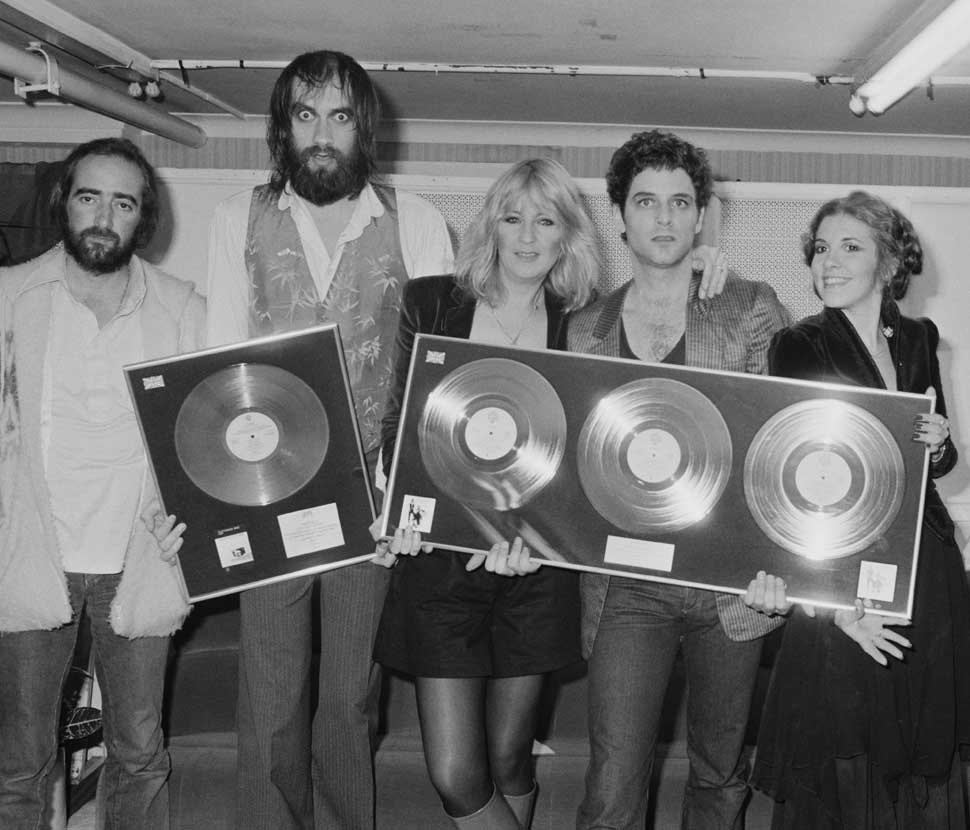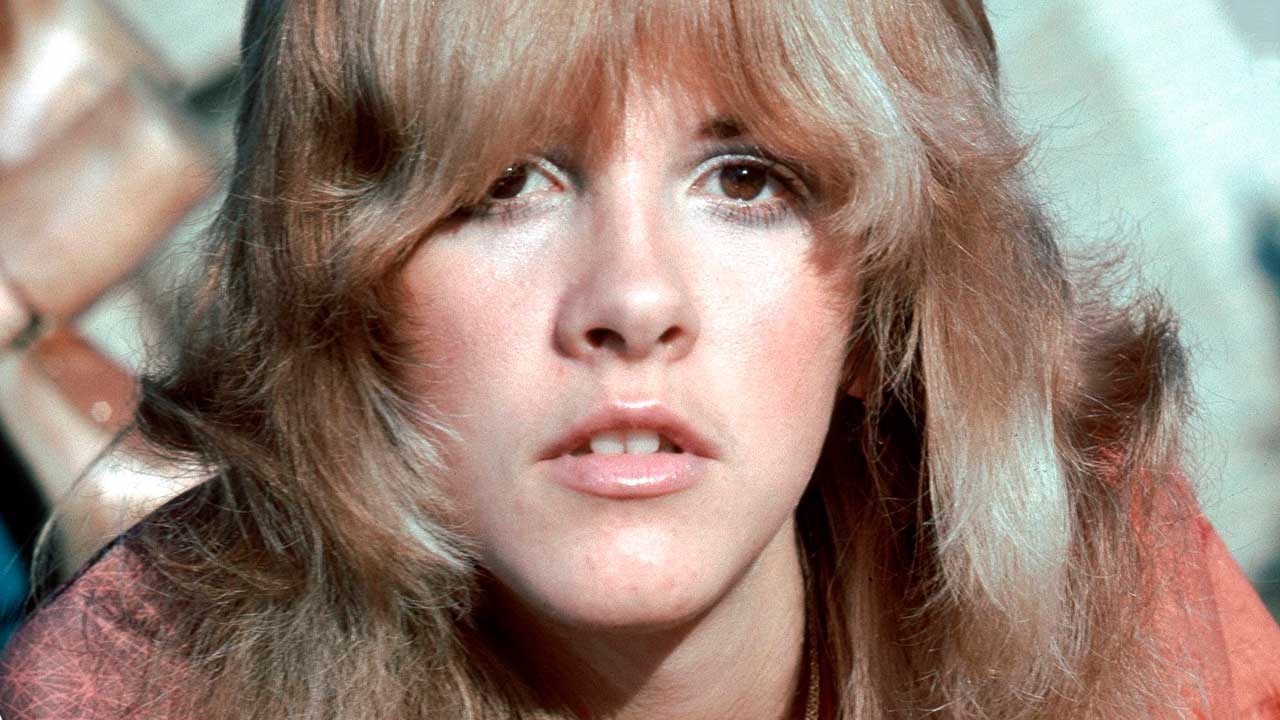It’s September 1980. From the deck of the Pacific Palisades home that Stevie Nicks was sharing with her new boyfriend, producer Jimmy Iovine, you could hear the hypnotic push and pull of the ocean.
Inside, among the tropical plants, Persian rugs and paintings of dragons and gypsies, there was the even more alluring sound of three siren voices dovetailing in perfect harmony. Stevie and Lori Perry and Sharon Celani, her two closest friends, would spend hours around the upright piano, singing everything from old country and western covers to Stevie’s new songs.
It was here that the seeds took root for Bella Donna, the breakout solo record that forever changed both the dynamic in Fleetwood Mac and Nicks’s life as an artist. Exhausted from the previous two years of high-stakes drama around the recording and touring of Fleetwood Mac’s epic double album Tusk, the 32-year-old singer welcomed the laid-back setting and easy camaraderie with her girlfriends.
“In Fleetwood Mac there’s always a chaos,” Nicks told me in 2003. “It’s not easy for us. It never will be. It hasn’t ever been. Whenever we get back into a room together and start working, we don’t agree on a lot of stuff. And we’ve fought through every single record we have ever made.”
Part of that fight was getting songs on a record. Having three songwriters in Mac meant that after six years in the band Nicks had built up a backlog of unused top-drawer material.
“When we’d do an album, they’d hear fifteen of my songs and invariably pick the two that were my least favourite,” she complained. “Some of my favourite songs wouldn’t get used.”
Iovine agreed to work with her on a solo project with an approach that would replace the Mac’s careful deliberations with a more live sound. His previous credits included John Lennon, Meat Loaf and Bruce Springsteen. But it was Iovine’s records with Tom Petty & The Heartbreakers that really grabbed Nicks. She told him she wanted a “girl version” of Petty’s sound.

Outside of Fleetwood Mac, Nicks had been flirting with a few projects. She wrote a song cycle around the Welsh mythological goddess Rhiannon for a film (despite having the screenwriter for The Man Who Fell To Earth attached, it never got made). She also sang on Kenny Loggins’s Whenever I Call You Friend and Walter Egan’s Magnet And Steel, both hits. But the idea of releasing an album under her name was still somewhat scary.
“It’s a big deal the first time you do a solo record,” Benmont Tench tells Classic Rock. The Heartbreakers’ keyboard player was tapped by Iovine to act as “musical director” for Bella Donna. “And remember, back then, if somebody in a huge band made a solo record, your first thought was: ‘Wow, is the band breaking up?’ It was really unusual and risky to step away.
"But Stevie may have just gone: ‘Look, I’ve got these songs, let’s do a record without the family baggage there was around Fleetwood Mac.’ Stevie, Christine [McVie] and Lindsey [Buckingham] only got three songs per record. That’s why Silver Springs didn’t make it on to Rumours. Give the woman a fourth song, for God’s sake! [laughs]”
Tench had met Nicks briefly when the Heartbreakers backed her on a recording of Outside The Rain the year before (the track ended up on Bella Donna). But he admits he revised his first impression of her.
“I had seen Fleetwood Mac play, and with Stevie I just didn’t get it,” he says. “She could sing, oh hell yes. But I didn’t know what was going on with the top hat and the twirling and the witchy stuff. But then I bought the single to Go Your Own Way and flipped it over, and there’s Silver Springs. Good Lord, what a song. The second I heard that, I went: ‘Now I get it. That’s Stevie. She’s not faking. She’s for real. She’s not a poser in the least. She’s a creative perpetual-motion machine. This is somebody I’d really love to play music with.’”

For two months, Tench, Nicks and her girlfriends rehearsed five days a week. “We were like Joni Mitchell and Crosby, Stills And Nash, living in this great house and making music,” Nicks remembers. “It was one of those real rock’n’roll experiences that you can never forget.”
“It was song after song after great song,” Tench recalls. “I think she had enough for her first three solo albums and beyond. Lori and Sharon were so instinctive and so intuitive. They were all so tuned in to each other. At the drop of a hat they’d break into a cappella versions of old songs like Chapel Of Love. They loved each other and loved to harmonise. They stood behind me at the piano, and when I heard their three voices together it was just: ‘Wow’, goosebumps.”
With most of the songs chosen, recording sessions started in November at Studio 55 in Los Angeles. Built in the 1940s by Decca Records, it was the studio where Bing Crosby recorded White Christmas. Working from late afternoons into the small hours, Tench settled in with the all-star team that Iovine had assembled, full of what Iovine called “band guys” rather than session players: E Street Band pianist Roy Bittan, Elton John’s guitarist Davey Johnstone, and Linda Ronstadt’s drummer Russ Kunkel, bassist Lee Sklar and guitarist Waddy Wachtel.
“Jimmy pulled members from all these iconic bands to come and make music for Stevie,” Russ Kunkel tells Classic Rock. “What a genius idea. He was the first producer I ever worked with who came out on the floor with the musicians during the rehearsals, sat there with headphones, dialling in a great mix for us. That inspired us and brought us to the take quicker.
"Even during the take he stayed in the room with us, dancing around. He was part of the vibe. So there was never that pregnant pause after a take, where you wait for the producer’s voice from the other side of the glass, saying: ‘Let’s do another one,’ and you’re immediately rejected [laughs]. Jimmy was out there with us. That’s a huge thing.”
“Jimmy knew how to run sessions, and make things happen quickly,” Waddy Wachtel adds. “The luxuriant approach of taking a year to make a record like Tusk is kind of an aberration. And I think Stevie was glad to be working in a more spontaneous way. Jimmy was great at getting performances out of the band and out of Stevie. He had a really intuitive sense about songs, lots of enthusiasm and energy.”
“We recorded all the songs essentially live,” Tench says, “with the whole band cutting at the same time, and Stevie, Lori and Sharon singing with us on the floor. We captured a beautiful feel. The ambience of the studio was gorgeous, aesthetically pleasing. Stevie brought the ambience, not necessarily in items from her house, but just the spirit. The same mood that was in her house made it to the vocal booth.”
At the heart of the sessions was the flowering personal relationship between artist and producer. “Jimmy and I were totally in love,” Nicks wrote in the sleeve-notes for the Bella Donna reissue. “The record was our love story unfolding.”
The feeling and camaraderie came through on the title track’s moody, ribbon-like reverie, the top-down West Coast pop of Think About It, the Nashville twang of After The Glitter Fades, and Leather And Lace, a chart-topping tender-but-tough romantic duet with the Eagles’ Don Henley (Nicks originally wrote it for Waylon Jennings and Jessi Colter).
And throughout, Perry and Celani’s voices were there, weaving counterpoint and harmony around Nicks. The strength they gave their friend is reflected in the album’s lyrics, which never tip towards wallowing or weakness. The solo Nicks refuses to play a victim of anything, be it love or interpersonal power struggles. She’s less witchy woman, more warrior.

The two monster hits that made Bella Donna a juggernaut arrived late in the sessions. And one almost didn’t make the album. It was no secret that Nicks was a Heartbreakers fan. She’d even fantasised in the press about quitting Fleetwood Mac and joining them. Short of being in the band, Nicks convinced Petty to write her a song. He came up with Insider. But after they recorded it together, Petty liked it so much he decided he didn’t want to give it away. Nicks understood. Out of what Petty called “terrible guilt”, he played her a few cast-offs from the album he was making, Hard Promises, and she jumped at Stop Draggin’ My Heart Around.
“Jimmy knew that that song could be a hit for Stevie and could help launch her album,” Tench recalls. “But I think Tom assumed they’d re-cut it rather than keeping our original track.” The song’s irresistible swampy groove, punctuated by Mike Campbell’s searing guitar stabs and Tench’s Booker T-like organ fills, brought out a sassy repartee between the singers, even if their virtual duet was concocted in secret by Iovine.
Petty’s initial reaction was not enthusiastic. “He plays me Stop Draggin’ My Heart Around, the same track, with her singing,” Petty said in the documentary Runnin’ Down A Dream. “I go: ‘Jimmy, you just took the song?’… His comeback was, like: ‘This is gonna buy you a house.’ But it pissed me off because it came out at the same time as our single [A Woman In Love], and I think ours suffered.”
Strangely enough, Nicks was also against the song, because she wanted all the material on the album to be her own. When Iovine suggested she record a duet, she stormed out of the studio. “Then I stormed back in and said: ‘Okay, you’re absolutely right. I’m sorry for being so bitchy about this, it’s just that I’m so protective of my songs.’ And because of that song, I have a solo career to this day.”
Equally as important was Edge Of Seventeen. The evocative title came from a misheard comment. Nicks had asked Petty’s then-wife Jane when they met, and she replied: “At the age of Seventeen.”
“Jane had a southern accent, and I heard ‘edge’,” Nicks told me. “I wrote the title down. And the song was written right after John Lennon died. A week later, my dear uncle John died. My cousin and I were with him when he passed. Between John Lennon and my uncle, the song came out of that. ‘Oh I went searching for an answer, up the stairs and down the hall/Not to find an answer, just to hear the call of a nightbird singing… And the nightbird is the bird of death, really.
"So I can get up on stage and sing Edge Of Seventeen and still feel just as traumatised today as I did then, when I first sang it at my piano. It’s just so heavy. I use that word a lot. I know that it’s an old hippie word, but it just really seems to be the right word. Some of the songs are so heavy.”
And ‘heavy’ was the feeling Wachtel wanted on guitar when he heard the demo. Iovine asked him to play the part using an echo effect.
“I said: ‘No way, I’m not doing that.’” Wachtel says. “He said: ‘What do you mean?!’ I said: ‘It’s too light with the echo effect. It needs some muscle behind it.’ I played them that rhythm with a pick, and they said: ‘Yeah, let’s do it that way!’”
“Waddy’s part is like a steel hammer driving the song,” Kunkel says of the line that would later be sampled for the Destiny’s Child hit Bootylicious. “And it allowed me to play around it. I remember [engineer] Chuck Plotkin coming out, standing in front of my drums and stomping his foot on these off-beats. I was thinking: ‘Are you having a coronary?’ [laughs]. It took me a minute to get used to his suggestion, but it’s one of the things that makes the song so unique.”
With the recording finished, Nicks tapped photographer Herbert Worthington III (who’d done Rumours) for the cover. His photos forever crystallised Nicks as the mystical woman in chiffon.
“What I’m wearing is the exact opposite of my black outfit on Rumours,” she told Rolling Stone. “Over that it says: ‘Come in from the darkness…’, which is the dark side of anyone, the side that isn’t optimistic, that isn’t strong.”
Of the shaded meanings of the album title, Nicks wrote: “It meant beautiful woman, but also poisonous root. People use it [the belladonna plant, aka deadly nightshade] for healing, but if you take too much you can die. I thought: ‘This is the perfect double-edged sword title for the record.’ And there was another double-edged sword: would I have a successful solo career and would that make Fleetwood Mac look good, or would I have an unsuccessful solo career and would that make them look bad? Or would they be petty enough to want it to not go well so they’d know they’d always have me?”

Bella Donna was released in July 1981 on Nicks’s own imprint Modern Records, via Atlantic (set up by her manager Irving Azoff, it was a forward-thinking move), to mostly positive reviews and tons of airplay. Within three months it was a platinum-selling No.1 album. With Tench and Wachtel in her band, Nicks did a 14-date tour full of what she called “spectacular moments”, but then was yanked back into Fleetwood Mac world when they started recording Mirage in France.
“I woke up three days later, in France, with no ice, no air-conditioning, in this stupid castle, and I’m thinking: ‘What just happened? Did I dream the entirety of that record?’” Nicks wrote. “And Lindsey was not in a very good humour because I’d just made this solo record and I’ve brought my new producer boyfriend with me. They almost got in a fight. Jimmy was meant to be there for ten days but he left the next morning, he was so pissed off.”
The first of Nicks’s seven solo albums, Bella Donna remains the most influential and resonant. Its ripples can be felt in records by Lana Del Rey, Florence And The Machine and Belle Brigade. And whenever female musicians fight for creative independence – think Kelly Clarkson overruling Clive Davis to make My December, or Taylor Swift breaking out of her country box with 1989 – Nicks is there as a guiding light.
She worked with Jimmy Iovine on two more records before they split as a couple. Both Sharon Celani and Lori Perry (the latter now married to Nicks’s brother) have stuck with Nicks (they even toured with Fleetwood Mac in 2019). Ironically, Nicks’s solo flight probably helped keep her in Mac (she left briefly in the early 90s), if only because it gave her another means of expression and put a kind of ‘get out of jail’ card in her back pocket.
In 1981 she told US magazine: “It’s difficult to be a girl in a big rock’n’roll group for six years. You’re very protected and dependent. For so long you’re not allowed to make your own decisions, that suddenly you don’t want to any more. Doing my solo album was the only step I could take to show I still had control.”

Twenty years later, Nicks told me: “My solo career is very precious to me. But it can never be like Fleetwood Mac. For each of the members of the band and everyone surrounding us, it’s so much more heavy. There’s that word again. When I’m working by myself, it is by myself. I’m very inward and very much a loner, but Fleetwood Mac just overwhelms everything, takes everything. Everybody in the band is possessive and jealous. I don’t know what else to say about it. It makes my whole face turn red. I get a fever.”
Waddy Wachtel, who’s been in Nicks’s touring band since Bella Donna, and is working on an album with his group the Immediate Family, says: “The fire that was in Stevie at that time was remarkable. She and I always got along, but she had this thing where she’d say: ‘I know you don’t like what I do’ and laugh.
"Early on I didn’t really get her. When we went out on the road to tour Bella Donna, I remember we had a great first night, and we were all sitting around and toasting. I said: ‘I’ve got to tell you that I’m really impressed by what you did tonight. I don’t use this term lightly, but you are a fucking rock’n’roller, girl.’”
“I’m amazed by how contemporary the album still sounds,” says Russ Kunkel, who is also in the Immediate Family. “That’s really the true test, isn’t it? If it still sounds contemporary forty years later, then you did something right.”
Benmont Tench, who is finishing his second solo album, says: “Stevie had never made an album where it was all on her shoulders, with the pressure that comes with that. Also with the freedom that comes with that. And she just nailed it. Her vocals are incredible. If you were a singer in a group with harmony, like the trio she had with Lori and Sharon, then you have got to have great pitch. You couldn’t do anything back then about fixing pitch.
"You might be able to punch in a line, but you couldn’t mess with it electronically. So when I listen to Bella Donna now, I think: ‘Yeah, Stevie is a total badass.’”



